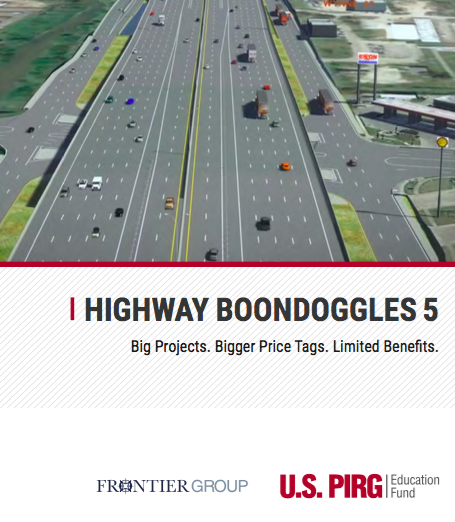Frontier Group and USPIRG’s annual report on highway boondoggles calls out the Oregon DOT’s wasteful, ineffective I-5 Rose Quarter freeway widening project as a national level boondoggle.
Portland is famous for making top ten lists when it comes to urban transportation policy, what with its number one in the nation share of big city bike commuters, its pioneering efforts to revive the streetcar and similar measures. But today it’s on a list that clearly signals the city is headed in the wrong direction.
Today, Frontier Group and the OSPIRG Foundation released its annual report identifying the worst highway projects in the nation. Among the nation’s top nine highway boondoggles for 2019: the Oregon Department of Transportation’s proposed half billion dollar widening of the I-5 freeway near downtown Portland. The report says:
In Portland, a city that has taken great strides toward more sustainable transportation, an expensive highway project would constitute a step backward to the car-dependent policies of the past. It would also likely fail to meaningfully improve safety compared with other investment strategies.
The award comes on top of a long list of critical comments from national transportation policy experts including Robin Chase, Janette Sadik-Khan, Jeff Speck, and others.
For the past five years, the Boondoggles report has cataloged the worst proposed highway projects in the nation. In several cases, the projects have stalled or been cancelled, with big savings for state and local taxpayers and positive results for transportation and the local economy. For example, local groups stopped the widening of I-275 in Tampa Heights, and the community is thriving, with new restaurants and businesses, and even e orts to reduce tra c capacity on local roads to improve walking and biking. Wisconsin scaled back its freeway widening plans, shifting more resources to a “fix it first” maintenance strategy designed to take better care of existing roads. Freeway removals, like the closure of Seattle’s Alaskan Way viaduct showed that reducing road capacity causes traffic levels to decline.
It will come as no surprise to regular readers of City Observatory that the Rose Quarter freeway widening project has all the hallmarks of a boondoggle. We’ve chronicled dozens of reasons that the project shouldn’t go forward:
- It will do nothing to relieve chronic congestion on I-5, according to city and state estimates
- While pitched as a safety project, this section of I-5 is much safer than other state-run highways in Portland
- When the Oregon DOT widened a nearby stretch of I-5, crashes didn’t go down, they went up.
- Widening the freeway will generate induced demand for travel, adding millions more miles of vehicle travel annually and increased air pollution and carbon emissions.
- The freeway widening project degrades bike, pedestrian and transit access in the Rose Quarter neighborhood
- Freeway widening will impair air quality at Tubman Middle School, which has already had to spend $12 million in education funds to filter freeway pollution out of classroom air
- The Oregon Department of Transportation’s planning and public outreach efforts have been rife with deceptions and lies
All-in-all, the Rose Quarter freeway widening project is a classic boondoggle. One can only hope that this critical national attention will help state, regional and local leaders recognize that moving forward with the project is a tragic blunder, one at odds with our stated values.
Full disclosure: City Observatory was provided with a draft copy of the report prior to its publication and was offered the opportunity to comment on the report. It was not compensated for providing its comments.
Note: This post has been revised to reflect the report’s sponsorship by the OSPIRG Foundation.


